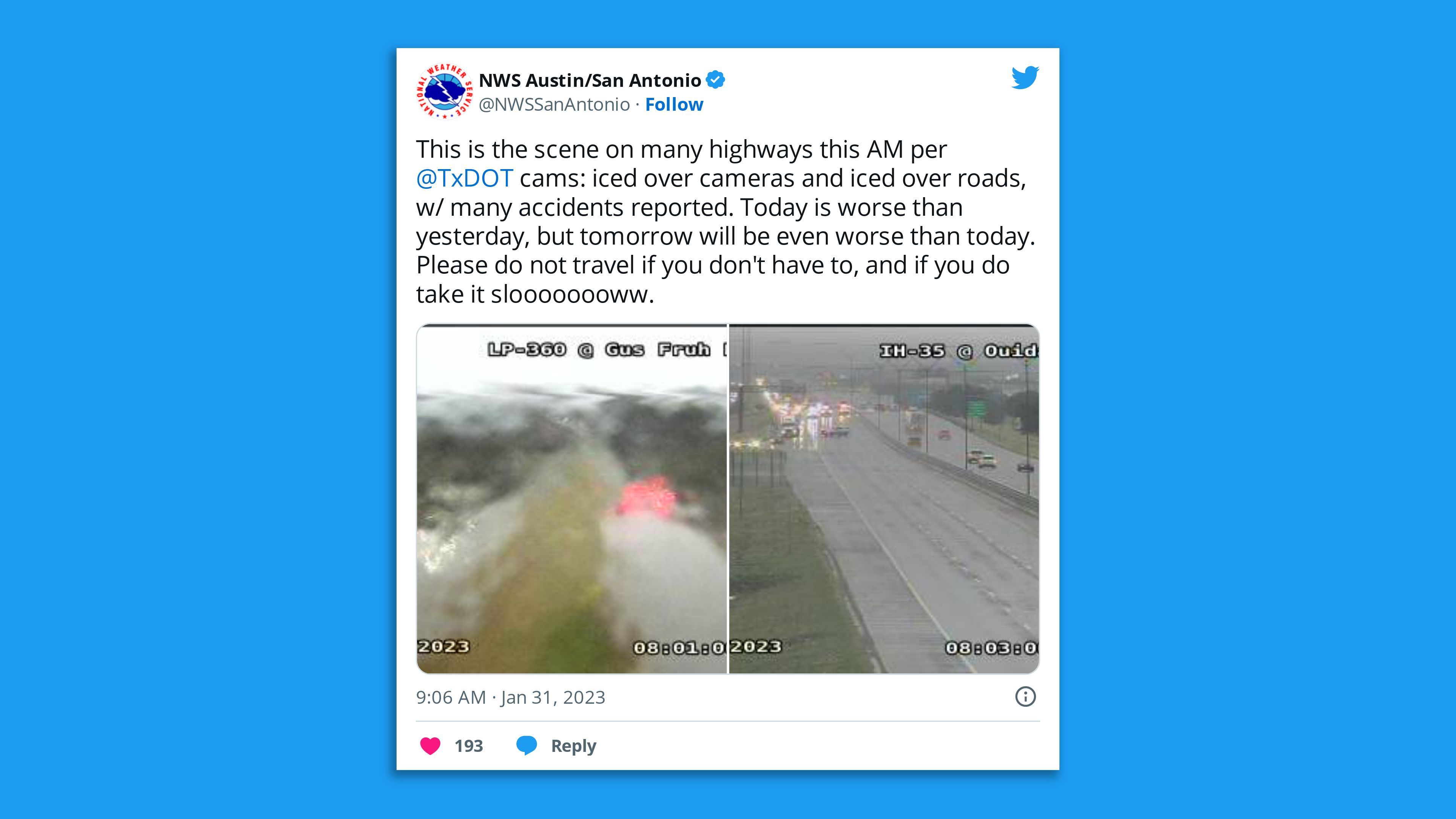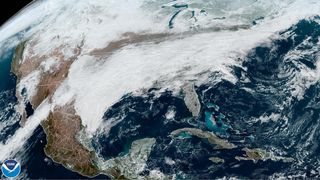[ad_1]
Satellite image showing the winter weather stretching from Texas to the Mid-Atlantic. Image: NOAA
The combination of moisture from the Gulf of Mexico and Arctic air spilling south from Canada is resulting in a long-duration ice storm for millions of people, across at least eight states.
The big picture: At least two people in Texas have died as sleet, snow and freezing rain snarled road and air travel in Dallas on Tuesday. Waves of mixed precipitation are forecast to spread northeast with time, lasting through early Thursday in some areas.
- The National Weather Service is warning of “significant impacts” from the freezing rain and sleet. Winter storm warnings are in effect for most of Texas, and thundersleet has been observed, including in Dallas-Fort Worth.
- Numerous car accidents were reported along the Interstate 35 corridor between Dallas and Oklahoma City Tuesday, and Austin police reported dozens of accidents, including some involving their own personnel, from midnight through Tuesday morning.
- One person was killed in Austin after being involved in a traffic pileup Tuesday. Another person, a 45-year-old man, died Monday night after his vehicle slid into a highway guardrail near Dallas amid icy road conditions, causing him to roll down an embankment, per AP.
- On Tuesday afternoon, the NWS forecast office in Dallas issued an ice storm warning for up to a half-inch of ice accumulation in areas west of I-35, including Ft. Worth, Denton and Mineral Wells. This could cause tree damage and power outages, NWS warns. The next significant round of wintry precipitation is expected to fall Wednesday into Thursday.
Threat level: The wintry mix, which was falling heavily in some areas, was expected to worsen in the near-term.
- “Travel should be avoided if possible now through early Thursday. Stay home!” warned the NWS forecast office in Dallas.
- “Multiple rounds of wintry precipitation are forecast, with brief lulls followed by bursts of sleet and freezing rain that could drastically deteriorate road conditions,” the Weather Service said in an online forecast discussion.
- Where mostly freezing rain will fall, widespread ice amounts of more than 0.25 inches was expected — with some places picking up as much as 0.75″. Ice amounts above a half-inch can weigh down trees and power lines, causing outages.
- The areas at greatest risk for power outages looks to be from Little Rock to Memphis, as well as portions of Texas. “Significant accumulations of ice and sleet are expected across much of the area, resulting in widespread impacts to travel and infrastructure,” the NWS forecast office in Memphis stated in a forecast discussion.
- At 9:40 p.m. ET, more than 31,000 customers were without power in Texas, according to PowerOutage.us.

Flight delays
- In addition to the treacherous roadways, the winter storm was also causing air travel delays that are rippling out across the country.
- Through 9:40 p.m. ET, 1,963 flights within, into or out of the U.S. had been canceled Tuesday. The majority of flights are coming from or going to Dallas Ft. Worth International Airport, according to FlightAware data. At least 4,616 flights had been delayed.
- Memphis International Airport, the main hub for FedEx, as well as Austin and Nashville, have also been seeing numerous flight cancellations or delays related to the winter storm.
Arctic air sets records
What’s next: The cold air responsible for the icy mix has been setting records in the Rockies and Plains, and by this weekend, one of the coldest outbreaks in years, possibly decades, will roar into New England.
- Tuesday morning saw the temperature in Wyoming dip to the minus-30s, and Denver reached a record low of minus-10 on Monday.
- A piece of the polar vortex in the lower atmosphere will whip from Hudson Bay across New England Saturday, sending temperatures plunging amid strong northwesterly winds.
- Wind chills in Boston could reach minus-30°F, with minus-50°F wind chills a possibility in northern New England.
- Fortunately, the Siberian-level cold will be brief, with temperatures moderating by Monday.
Editor’s note: This article has been updated with additional details throughout.
[ad_2]
Source link
